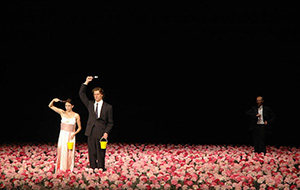 Applications are now open for the 2017 Pina Bausch Fellowship for Dance and Choreography, awarded annually. Open to artists from around the world, the fellowship enables the recipient to explore the techniques of a renowned choreographer by becoming a temporary member of the ensemble of their choice.
Applications are now open for the 2017 Pina Bausch Fellowship for Dance and Choreography, awarded annually. Open to artists from around the world, the fellowship enables the recipient to explore the techniques of a renowned choreographer by becoming a temporary member of the ensemble of their choice.
The Pina Bausch Fellowship enables dancers and choreographers to extend their own repertoire of movement and find new and individual means of expression within dance, elongating their experience and practice. Recipients will present the results of their time with their chosen ensemble at final presentation in Wuppertal, Germany. There are up to four fellowships on offer, with no age limit for applicants.
The judging panel responsible for awarding the 2017 Pina Bausch Fellowship is made up of three dance professionals, namely Ana Laguna (dancer and spouse of Mats Ek), Christophe Slagmuylder (Artistic Director Kunstenfestivaldesarts), and Yorgos Loukos (Artistic Director Dance / Opéra de Lyon, Artistic Director Athens & Epidaurus Festival). In this hugely beneficial experience, participants can expect to grow as individuals and artists, extending their practice and developing their work further.
An official degree in dance or choreography is not a requirement for an application to the Pina Bausch Fellowship for Dance and Choreography. The Fellowship is therefore open to all dancers with a professional working experience of at least two years, demonstrable through the application process. Choreographers need to have produced at least one public production in the last three years.
The application period for the Fellowship 2018 begins on 1 June and ends on 15 September 2017.
Applications for the 2017 Pina Bausch Fellowship for Dance and Choreography are open until 15 September 2016. For more information visit https://fellowship.pinabausch.org/en/home
Category: Uncategorised
English National Ballet’s Giselle
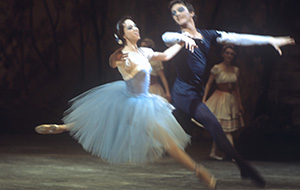 In a fresh take on the classic, an all new Giselle for English National Ballet will be eagerly anticipated by both traditional balletomane audiences and contemporary audiences. Khan’s Kathak influences will mean his Giselle for the boundary-pushing ballet company will be a complete refresh of the story, moving away from the perfection of pointe shoes. His curiosity as a choreographer will see many innovations on stage for English National Ballet.
In a fresh take on the classic, an all new Giselle for English National Ballet will be eagerly anticipated by both traditional balletomane audiences and contemporary audiences. Khan’s Kathak influences will mean his Giselle for the boundary-pushing ballet company will be a complete refresh of the story, moving away from the perfection of pointe shoes. His curiosity as a choreographer will see many innovations on stage for English National Ballet.
Giselle will be the company’s second collaboration with Akram Khan, lead by artistic director Tamara Rojo to shake up the traditional story that is deeply engrained in the history of classical ballet. Embedded in Romantic classicism, Giselle tells the tale of the tragedy of a girl driven mad by love and lies. Her death at the end of Act I is only the beginning: Act II is set by her grave. The revenge on her lover is at the hands of the Willis, seeing him dance to his death also.
It is clear this new take on the classic tale will be telling for the entire art form. With the move of the company to east London imminent in the next few years, Khan’s Giselle will be another keystone in the company’s history, and that of ballet too. The ballet originally premiered in 1841, and Khan’s take on it will be observed by many, his spiritual approach to dance echoed in the tale itself. As an innovator he has worked with film stars, ballerinas and artists, as well as on the 2012 Olympics opening ceremony.
The team of collaborators are set to produce a visual spectacle. Tim Yip, who worked on the design for the film Crouching Tiger, Hidden Dragon, takes on sets and costume, and composer Ben Frost will adapt the original Adolphe Adams score to be performed by the ENB Philharmonic. Ruth Little, who worked as the dramaturg on Khan’s piece Desh, will look after the narrative.
Keeping dancing
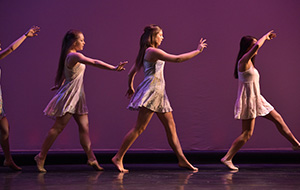 Whilst many young dancers dream of becoming a professional, as age and experience increase there is sometimes the realisation that this may not become a reality. Despite this, there are many opportunities at school or college to continue to be involved in dance, without studying it solely at vocational level or in higher education.
Whilst many young dancers dream of becoming a professional, as age and experience increase there is sometimes the realisation that this may not become a reality. Despite this, there are many opportunities at school or college to continue to be involved in dance, without studying it solely at vocational level or in higher education.
Many institutions have a dance club or group outside of studies, or may even have a gymnastics or cheerleading team if you wish to try something different. Some dance groups may require an audition before joining, whereas others are light-hearted and just for fun. In addition to dancing, you could be heavily involved in other areas such as choreographing, being the dance captain, teaching technique classes, notating choreography, making or adjusting costumes and arranging music.
Universities and colleges use fresher fairs at the beginning of each year to tell new students about opportunities they can be involved in on campus. Most dance groups are student-run, giving members the chance to shape it in the way they would like, and introduce the content they would like to take part in. The many genres within dance mean there are many different options – you might find tap groups, Bollywood groups, or even for pointe work. These groups are open to all despite technique level, and can be a great way to meet new people outside your course.
Keeping up your dance practice away from home can also be done by finding a local studio that you can join or help out at. This will keep up your technique as well as fulfilling the need to be in the studio. An alternative could be to join fitness classes, such as aerobics, Zumba and yoga. Many dancers find new interests in fitness instruction, nutrition, physical therapy and personal training, which previous dance experience will complement. The bottom line is you do not have to give up dancing!
Circus spectacles
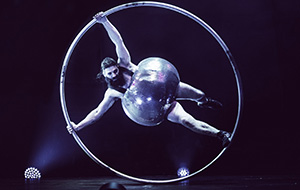 London Wonderground on the capital city’s South Bank is a whole mix of summer fun. With the long-awaited summer beginning to show its face, this fairground of London entertainment is a must-see and a must-do. With a huge programme of comedy, cabaret, dance, theatre and circus, the Udderbelly Festival is hugely popular and adorned with revellers rain or shine.
London Wonderground on the capital city’s South Bank is a whole mix of summer fun. With the long-awaited summer beginning to show its face, this fairground of London entertainment is a must-see and a must-do. With a huge programme of comedy, cabaret, dance, theatre and circus, the Udderbelly Festival is hugely popular and adorned with revellers rain or shine.
Part of the eclectic line up are the performances of Barbu, running in the London Wonderground Speigeltent. The Canadian circus company – going by the name of Cirque Alfonse – had its European premiere at the Edinburgh Festival earlier this year and another run at Underbelly’s new Circus Hub venue this summer, the first major venue dedicated solely to circus at the Edinburgh Festival Fringe.
The Spiegeltent is renowned for its programming of breath-taking performances and off-the-wall entertainment; the heart thumping score by the frenetic electro-trad band leads the way for Barbu, highlighting the company’s work and carrying the show through. With lots of similar performances on offer each year in the capital, London Wonderground is not a place to pass by. The Barbu show looks back to the origins of the circus in Montreal at the end of the 19th and beginning of the 20th centuries, with elements of the fairground, simple curiosities and unexpected eccentricities. Barbu therefore takes the bare bones of circus and turns them upside down in this hair-raising spectacle.
Cirque Alfonse has been exploring traditional and iconic Quebec images and integrating them into contemporary acrobatics. In the Lanaudière region of Quebec, the Carabinier-Lépine family and close friends joined forces in 2005, creating La Brunante which became the foundation for the show Timber! which premiered in 2010. Dubbed as London’s finest circus party, Cirque Alfonse clan’s third show Barbu is an bizarre and once-in-a-lifetime extravaganza.
The art of cleaning choreography
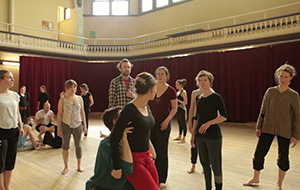 With creating and teaching choreography to dancers, there is an inevitable point when the choreography has sunk in and it must be cleaned or tidied up so it is consistent across each dancer. The piece may rely on counts, the lyrics of the music it is danced to or even simply breath, so if this has not already been ingrained in the dancers this must be the first thing to be specified and pinned down. This will hold the piece together so it is imperative to solidify this in the dancers’ brains, creating a framework for the rest of the cleaning.
With creating and teaching choreography to dancers, there is an inevitable point when the choreography has sunk in and it must be cleaned or tidied up so it is consistent across each dancer. The piece may rely on counts, the lyrics of the music it is danced to or even simply breath, so if this has not already been ingrained in the dancers this must be the first thing to be specified and pinned down. This will hold the piece together so it is imperative to solidify this in the dancers’ brains, creating a framework for the rest of the cleaning.
In order to clean sufficiently, break the choreography down into short sections, as it may be that the dancers do not perform in unison and the choreography therefore requires the coordination of different elements. It may be best to focus on each element each time the piece is run in order to solidify each one, fine-tuning each one with less distraction. Making notes throughout each run will help to give dancers their notes afterwards, as it can be distracting to call our corrections as they are dancing.
In making corrections, there are usually a combination of individual notes and quick fixes, in addition to issues for the bigger picture of the piece which need more work. Some may be problematic, such as sorting traffic across the stage during busy sections of the piece. These notes can be time-consuming but completely necessary to give the dancers confidence when performing the piece.
Whilst the technical elements of the choreography are intrinsic, artistic elements are the icing on the cake. The dancers’ focus is a huge must to pin down, and can be achieved by talking through the piece and the intention behind it at different stages throughout. Encourage the dancers to talk too, about what the piece means to them and what they feel they portray, allowing a more personal connection between the dancers and the piece.
Big Dance highlights for 2016
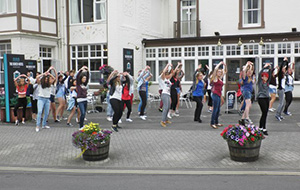 Big Dance 2016 saw 42,000 people take part in worldwide performance for the love of the art form. Not only were there Big Dance performances all over the UK, but also across the world in 44 countries, in locations such as Beirut, Tokyo, Texas and Hong Kong. Esteemed choreographer Akram Khan devised both the choreography and Big Dance online resources in order to involve dancers of all ages, from all types of communities and using many styles of dance.
Big Dance 2016 saw 42,000 people take part in worldwide performance for the love of the art form. Not only were there Big Dance performances all over the UK, but also across the world in 44 countries, in locations such as Beirut, Tokyo, Texas and Hong Kong. Esteemed choreographer Akram Khan devised both the choreography and Big Dance online resources in order to involve dancers of all ages, from all types of communities and using many styles of dance.
The Big Dance Pledge 2016 began in November 2015 at the University of Roehampton, London, where Khan worked with 60 students and the Big Dance creative team to create a piece of choreography to hand over to the rest of the world. By the end of the Worldwide Performance Day, 20 May 2016, over 42,000 people around the world had learned or used the choreography to create their own spectacular performances.
Wales saw the Big Dance Pledge used to improve the Welsh language skills of young people growing up bilingually, using words and sounds associated with the choreography. In Hong Kong, the CCDC Dance Centre, Hong Kong Academy for Performing Arts (HKAPA) and HKAPA Dance Alumni Association invited 100 participants to dance on site at the West Kowloon Cultural District, the first of its kind. In San Sebastiàn, Spain, the Olatu Talka Festival marked its opening – and this year’s European Capital of Culture programme – with British Council Spain supporting artists to learn and teach the Big Dance choreography for an open air performance.
Big Dance is by no means over. Next up is Big Dance Trafalgar Square on 2 July 2016, London’s final Big Dance, for which registration re-opened by popular demand. The Big Dance Bus Tour – until 10 September across London – will see a double-decker routemaster pop up in the most unusual places, creating ‘guerrilla-style’ dance experiences.
Northern Ballet’s Choreographic Laboratory
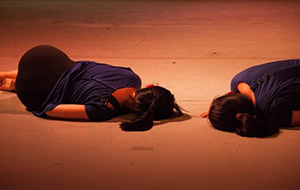 Northern Ballet has launched its second annual Choreographic Laboratory which brings together five emerging choreographers for a three-week intensive to research and develop ideas for new narrative dance, with Northern Ballet’s professional dancers. The Choreographic Laboratory culminates in Tell Tale Steps 2: Narrative in Ballet, a sharing at the Stanley & Audrey Burton Theatre in Leeds on 16 June 2016.
Northern Ballet has launched its second annual Choreographic Laboratory which brings together five emerging choreographers for a three-week intensive to research and develop ideas for new narrative dance, with Northern Ballet’s professional dancers. The Choreographic Laboratory culminates in Tell Tale Steps 2: Narrative in Ballet, a sharing at the Stanley & Audrey Burton Theatre in Leeds on 16 June 2016.
The Choreographic Laboratory began in 2015 by Northern Ballet’s Artistic Director David Nixon OBE. It is run in partnership with the Royal Ballet and curated by director and producer Jane Hackett, offering emerging choreographers the opportunity to work with Northern Ballet’s dancers to explore the creation of new narrative dance work. The scheme commits itself to nurturing choreographers and to developing talent. The experience therefore appears invaluable, with its wide ranging mentorship and tools on offer which are thought-provoking and challenging.
Carlos Pons Guerra (independent choreographer), Charlotte Edmonds (Royal Ballet Young Choreographer), Lucia Solari (First Soloist at Northern Ballet), Morgann Runacre-Temple (independent choreographer and choreographer in residence at Ballet Ireland) and Tobias Batley (Premier Dancer at Northern Ballet) have spent three weeks at Northern Ballet to explore narrative dance. The intensive also includes a programme of talks and mentorship from Sharon Watson, Artistic Director of Phoenix Dance Theatre and dance writer Luke Jennings.
The culmination of the Choreographic Laboratory is Tell Tale Steps 2: Narrative in Ballet, a sharing of the process of experimentation and research during the choreographers’ three week residency. The sharing will demonstrate their exploration of narrative dance, created characters and a sense of place and drama. The programme also includes a panel of leading arts professionals discussing the creation of narrative dance.
The Young Choreographer’s Festival
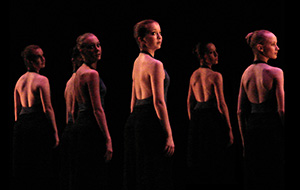 The Young Choreographer’s Festival in New York City is celebrating its seventh year of presenting some of the most promising up-and-coming young artists. It will produce the work of 13 18-25 year olds selected by a judging panel, alongside seven Guest Artists at Symphony Space. The 2016 performance is taking place on Saturday 18 June, including the genres of contemporary, contemporary Indian, modern, jazz and street jazz.
The Young Choreographer’s Festival in New York City is celebrating its seventh year of presenting some of the most promising up-and-coming young artists. It will produce the work of 13 18-25 year olds selected by a judging panel, alongside seven Guest Artists at Symphony Space. The 2016 performance is taking place on Saturday 18 June, including the genres of contemporary, contemporary Indian, modern, jazz and street jazz.
The Young Choreographers will be joined by Guest Artists including Derek Mitchell, Jenn Freeman, Open Call’s Innovate Award Winner – Connecticut Dance Conservatory, Shelly Hutchinson Collective, SynthesisDANCE/Tracie Stanfield and White Wave/Young Soon Kim Dance Company. For the past four years, the festival has offered a discussion panel open to all young choreographers selected from 2010 onwards. 2016 is no different, and the young choreographer will have the opportunity to hear from and question members of the dance community, hosted by a YCF Advisory Board Member.
Past panelists have included Maurice Brandon Curry (artistic director of Egelvsky Ballet), Darrell Grande Moultrie (with credits from Dance Theatre of Harlem, Beyoncé and Atlanta Ballet), Camille A. Brown (leader of Camille A. Brown and Dancers), Sidra Bell (head of Sidra Bell Dance New York), Laura Diffenderfer (an associate programmer at The Joyce Theater), Ashani Mfuko (the host of Inside NYC Dance television show), Yarden Ronen (executive director of Peridance Capezio Center) and Pascal Rekoert (a Lincoln Center scholar), so this year’s artists are in for a treat.
Each Young Choreographers will be provided with a mentor also. The 2016 mentors include Michelle Barber (Broadway Dance Center faculty member), Cheryl Copeland (teacher at Millenium Dance Complex), So You Think You Can Dance choreographer Shelly Hutchinson, Calen Kurka (producer of The Showcase Series), Kat Wildish (a former dancer with American Ballet Theatre and New York City Ballet), Lane Napper (a choreographer for Nickelodeon and Disney Channel) and Matthew Shaffer (author of “So You Want to be a Dancer?”).
Audition fees cap
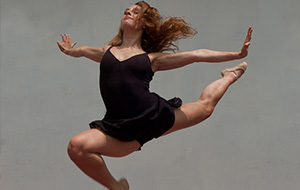 Drama and dance schools across the UK may be forced to rethink their audition fees, if a recent call by Equity to do so is anything to go by. The union has stated that audition fees should be capped in order to widen access to schools and improve accessibility to training. It is a notion that has been a hot topic for many organisations and industry professionals, as for many this training is only available to those who can afford it.
Drama and dance schools across the UK may be forced to rethink their audition fees, if a recent call by Equity to do so is anything to go by. The union has stated that audition fees should be capped in order to widen access to schools and improve accessibility to training. It is a notion that has been a hot topic for many organisations and industry professionals, as for many this training is only available to those who can afford it.
A motion passed at Equity’s Annual Representative Conference claimed that the acting profession should be “more representative of the population as a whole”, and the organisation has agreed to carry out an audit of the charges requested for auditions by drama schools across the UK. These fees can be as much as £85, before travel and possible accommodation costs in order to attend the audition. The union is aiming to campaign to encourage drama schools to adhere to a UK-wide cap on audition fees.
The cap would go a long way in improving the diversity of drama schools’ intake, as well as avoiding the fact that currently, it is usually only the well-off who can afford to choose which schools they want to attend for training. For some institutions, over 3,000 audition per year; many state that the audition fee covers the administrative and operations of the audition process, as well as paying the audition panel, however some students have short contact time and little to no feedback on their audition.
For some schools, auditions last all day; some have fee waiver schemes and support some students with travel bursaries also. Others try to encourage applications from talented students from lower income backgrounds, including launching a scheme to waive the fees for target schools, welcoming the transparency this move will bring.
Gaining stage presence
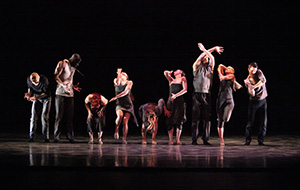 Stage presence is something that can come quite naturally to performers, however sometimes a little encouragement and pointers are required to propel a dancer in the correct direction. Whilst exceptional technique can be awe-inspiring, it is the entire package with emotion and commitment that makes a dancer unique.
Stage presence is something that can come quite naturally to performers, however sometimes a little encouragement and pointers are required to propel a dancer in the correct direction. Whilst exceptional technique can be awe-inspiring, it is the entire package with emotion and commitment that makes a dancer unique.
For a teacher, stage presence can be encouraged from an early age; as dancers grow older and progress, they may wish to compete against other dancers so must stand out. A flashy routine, however, will not always impress if there is no intention behind the movement or connection to the dance. Stage presence and a performance quality can seem elusive, but practice can aid this no end.
It is important for a dancer to commit to the story they are trying to tell, as well as connect to the music and express what they are feeling through movement. Energy, presentation and technique ultimately form a unique package, even for dancers who are inexperienced or reluctant to push themselves in a way which feels uncomfortable. Performing can be the most exciting experience and can conjure the most exhilarating emotions, and teachers can do much to nurture this.
As a teacher, encouraging students to appreciate and talk about successful performances can ensure they feel supported to express themselves. When students feel comfortable, their confidence grows and they will be more willing to try new things and push through shyness. Discussions and explorations throughout classes can help students to analyse and critique in a constructive way, in order to own and experiment with their performances, rather than choreographing empty presentation and expression.
There can be many ways to inspire students to push themselves further: by watching peers but additionally through their experiences of older and successful dancers, encouraging them to identify their performance qualities. By continually encouraging stage presence, can teachers help dancers experience a more seamless transition from practice to performance, even using classes as performance practice. Making this part of a dancers training will mean showmanship will evolve alongside technique.
